Organisational Behaviour: Comparing Tesco and ASDA Strategies
VerifiedAdded on 2019/12/03
|16
|6507
|249
Essay
AI Summary
This essay delves into the intricacies of organisational behaviour, using Tesco and ASDA as case studies. It begins by comparing and contrasting their organisational structures and cultures, highlighting the differences between Tesco's hierarchical structure and ASDA's flatter model. The essay then explores how these structural and cultural differences impact business performance, examining the factors that influence individual behaviour within these organisations. Further analysis includes comparing leadership styles, evaluating organisational theory's role in management, and assessing different management approaches used by both companies. The essay also discusses the effects of leadership on motivation, contrasting motivational theories like Maslow's and Herzberg's, and evaluating the usefulness of theories such as Elton Mayo's for managers. Finally, it examines group dynamics, factors affecting teamwork, and the impact of technology on team functioning within Tesco and ASDA, providing a comprehensive overview of organisational behaviour principles in practice.
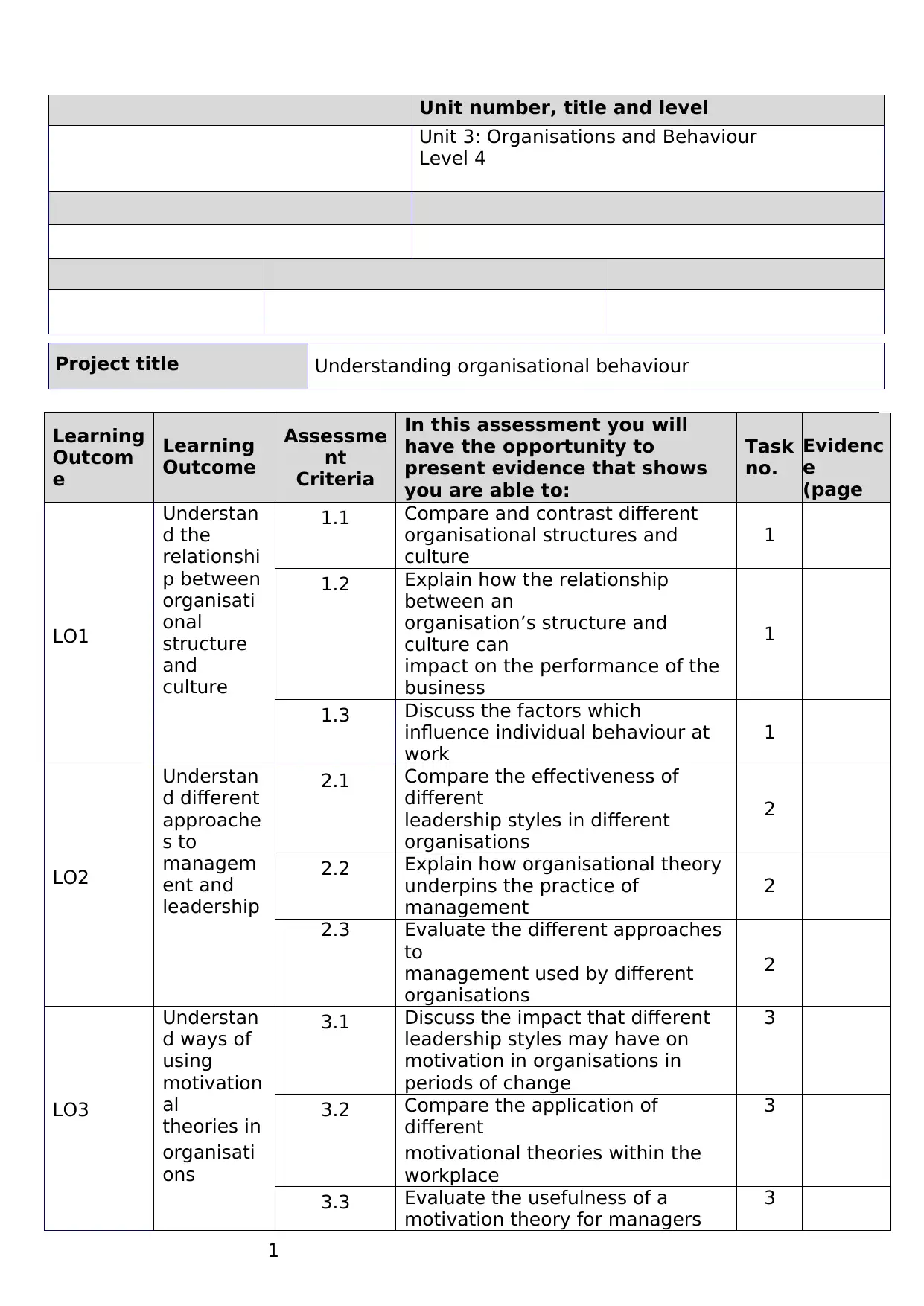
Unit number, title and level
Unit 3: Organisations and Behaviour
Level 4
Project title Understanding organisational behaviour
Learning
Outcom
e
Learning
Outcome
Assessme
nt
Criteria
In this assessment you will
have the opportunity to
present evidence that shows
you are able to:
Task
no.
Evidenc
e
(page
no.)
LO1
Understan
d the
relationshi
p between
organisati
onal
structure
and
culture
1.1 Compare and contrast different
organisational structures and
culture
1
1.2 Explain how the relationship
between an
organisation’s structure and
culture can
impact on the performance of the
business
1
1.3 Discuss the factors which
influence individual behaviour at
work
1
LO2
Understan
d different
approache
s to
managem
ent and
leadership
2.1 Compare the effectiveness of
different
leadership styles in different
organisations
2
2.2 Explain how organisational theory
underpins the practice of
management
2
2.3 Evaluate the different approaches
to
management used by different
organisations
2
LO3
Understan
d ways of
using
motivation
al
theories in
organisati
ons
3.1 Discuss the impact that different
leadership styles may have on
motivation in organisations in
periods of change
3
3.2 Compare the application of
different
motivational theories within the
workplace
3
3.3 Evaluate the usefulness of a
motivation theory for managers
3
1
Unit 3: Organisations and Behaviour
Level 4
Project title Understanding organisational behaviour
Learning
Outcom
e
Learning
Outcome
Assessme
nt
Criteria
In this assessment you will
have the opportunity to
present evidence that shows
you are able to:
Task
no.
Evidenc
e
(page
no.)
LO1
Understan
d the
relationshi
p between
organisati
onal
structure
and
culture
1.1 Compare and contrast different
organisational structures and
culture
1
1.2 Explain how the relationship
between an
organisation’s structure and
culture can
impact on the performance of the
business
1
1.3 Discuss the factors which
influence individual behaviour at
work
1
LO2
Understan
d different
approache
s to
managem
ent and
leadership
2.1 Compare the effectiveness of
different
leadership styles in different
organisations
2
2.2 Explain how organisational theory
underpins the practice of
management
2
2.3 Evaluate the different approaches
to
management used by different
organisations
2
LO3
Understan
d ways of
using
motivation
al
theories in
organisati
ons
3.1 Discuss the impact that different
leadership styles may have on
motivation in organisations in
periods of change
3
3.2 Compare the application of
different
motivational theories within the
workplace
3
3.3 Evaluate the usefulness of a
motivation theory for managers
3
1
Paraphrase This Document
Need a fresh take? Get an instant paraphrase of this document with our AI Paraphraser
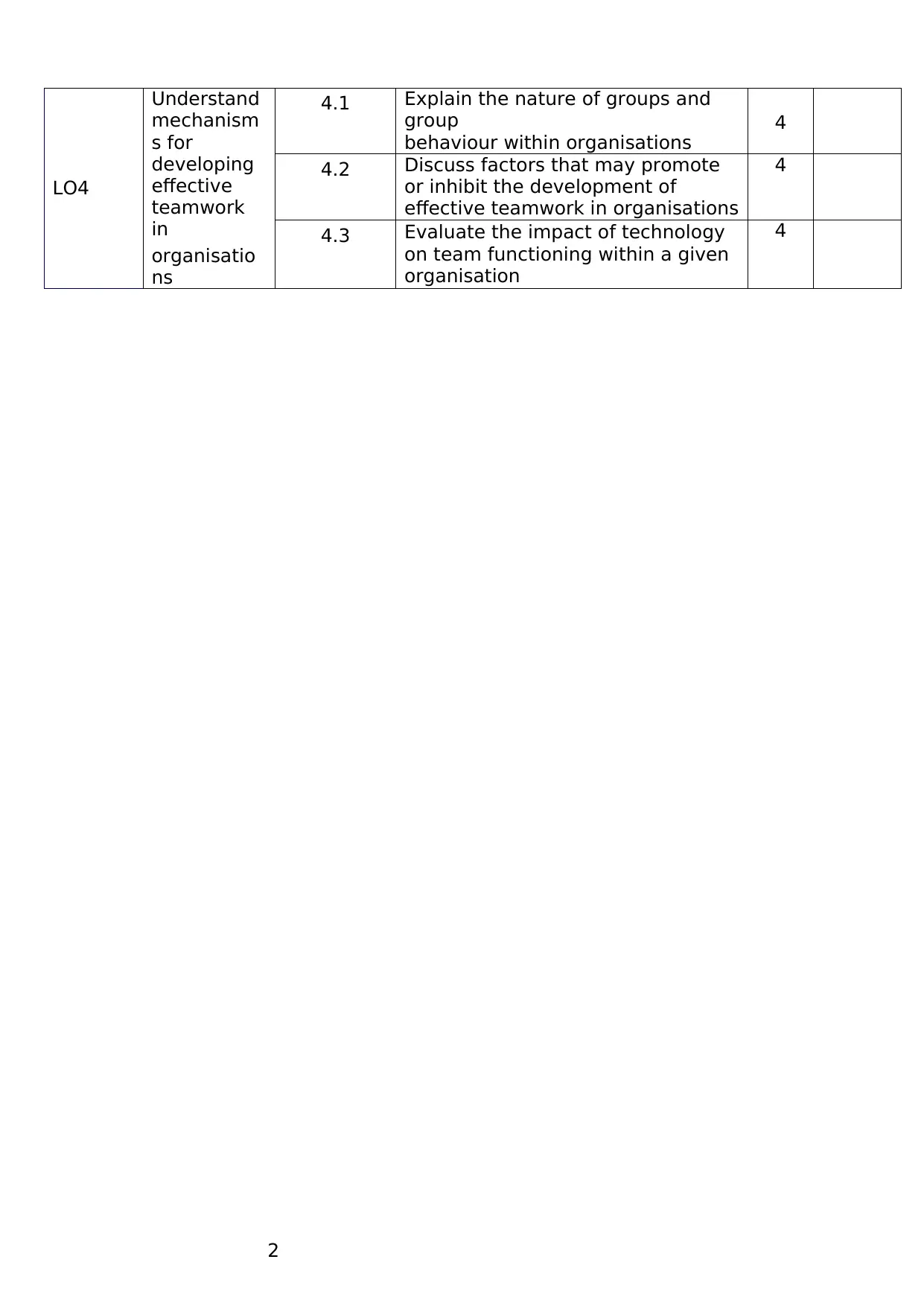
LO4
Understand
mechanism
s for
developing
effective
teamwork
in
organisatio
ns
4.1 Explain the nature of groups and
group
behaviour within organisations
4
4.2 Discuss factors that may promote
or inhibit the development of
effective teamwork in organisations
4
4.3 Evaluate the impact of technology
on team functioning within a given
organisation
4
2
Understand
mechanism
s for
developing
effective
teamwork
in
organisatio
ns
4.1 Explain the nature of groups and
group
behaviour within organisations
4
4.2 Discuss factors that may promote
or inhibit the development of
effective teamwork in organisations
4
4.3 Evaluate the impact of technology
on team functioning within a given
organisation
4
2

3
3
⊘ This is a preview!⊘
Do you want full access?
Subscribe today to unlock all pages.

Trusted by 1+ million students worldwide
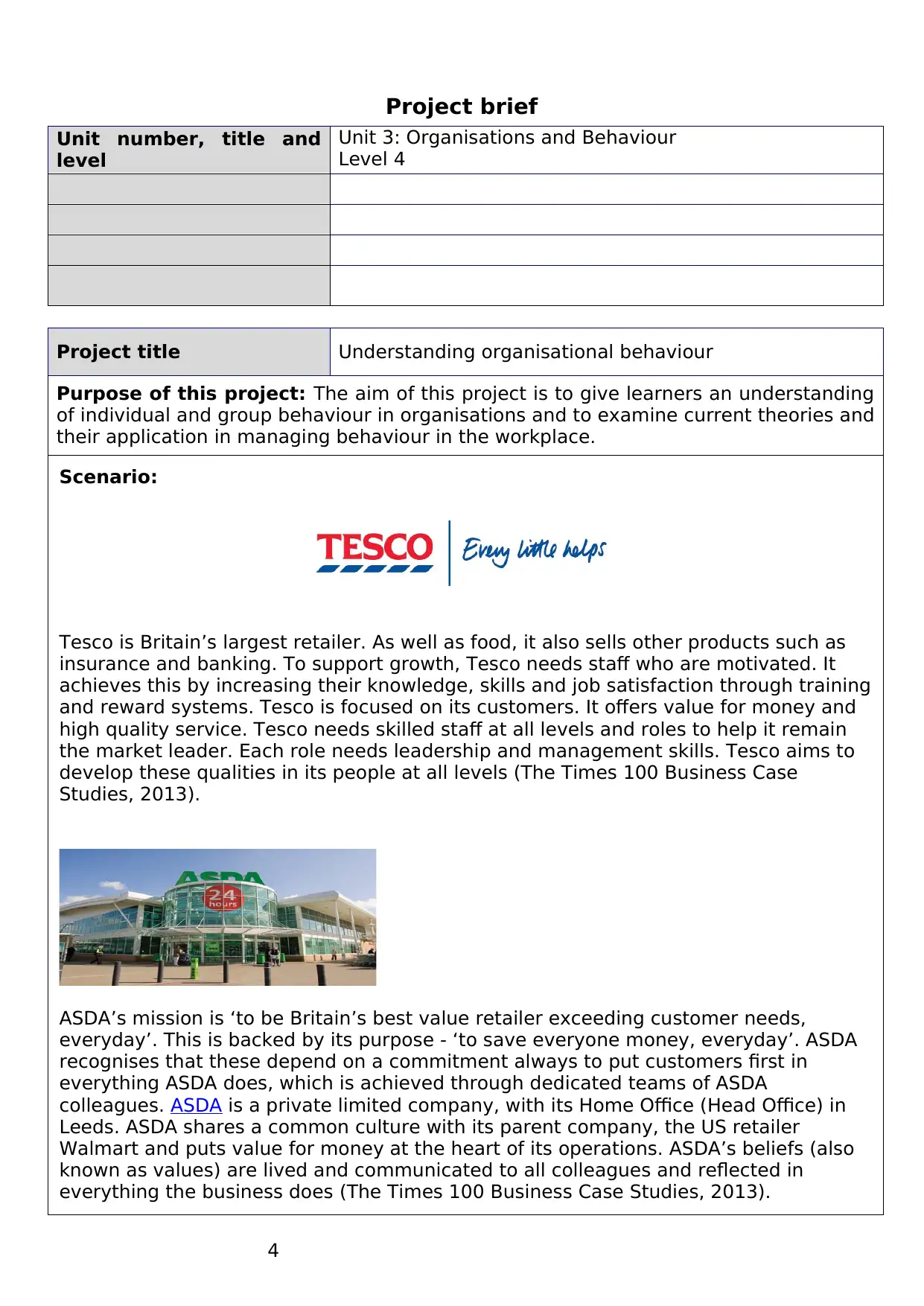
Project brief
Unit number, title and
level
Unit 3: Organisations and Behaviour
Level 4
Project title Understanding organisational behaviour
Purpose of this project: The aim of this project is to give learners an understanding
of individual and group behaviour in organisations and to examine current theories and
their application in managing behaviour in the workplace.
Scenario:
Tesco is Britain’s largest retailer. As well as food, it also sells other products such as
insurance and banking. To support growth, Tesco needs staff who are motivated. It
achieves this by increasing their knowledge, skills and job satisfaction through training
and reward systems. Tesco is focused on its customers. It offers value for money and
high quality service. Tesco needs skilled staff at all levels and roles to help it remain
the market leader. Each role needs leadership and management skills. Tesco aims to
develop these qualities in its people at all levels (The Times 100 Business Case
Studies, 2013).
ASDA’s mission is ‘to be Britain’s best value retailer exceeding customer needs,
everyday’. This is backed by its purpose - ‘to save everyone money, everyday’. ASDA
recognises that these depend on a commitment always to put customers first in
everything ASDA does, which is achieved through dedicated teams of ASDA
colleagues. ASDA is a private limited company, with its Home Office (Head Office) in
Leeds. ASDA shares a common culture with its parent company, the US retailer
Walmart and puts value for money at the heart of its operations. ASDA’s beliefs (also
known as values) are lived and communicated to all colleagues and reflected in
everything the business does (The Times 100 Business Case Studies, 2013).
4
Unit number, title and
level
Unit 3: Organisations and Behaviour
Level 4
Project title Understanding organisational behaviour
Purpose of this project: The aim of this project is to give learners an understanding
of individual and group behaviour in organisations and to examine current theories and
their application in managing behaviour in the workplace.
Scenario:
Tesco is Britain’s largest retailer. As well as food, it also sells other products such as
insurance and banking. To support growth, Tesco needs staff who are motivated. It
achieves this by increasing their knowledge, skills and job satisfaction through training
and reward systems. Tesco is focused on its customers. It offers value for money and
high quality service. Tesco needs skilled staff at all levels and roles to help it remain
the market leader. Each role needs leadership and management skills. Tesco aims to
develop these qualities in its people at all levels (The Times 100 Business Case
Studies, 2013).
ASDA’s mission is ‘to be Britain’s best value retailer exceeding customer needs,
everyday’. This is backed by its purpose - ‘to save everyone money, everyday’. ASDA
recognises that these depend on a commitment always to put customers first in
everything ASDA does, which is achieved through dedicated teams of ASDA
colleagues. ASDA is a private limited company, with its Home Office (Head Office) in
Leeds. ASDA shares a common culture with its parent company, the US retailer
Walmart and puts value for money at the heart of its operations. ASDA’s beliefs (also
known as values) are lived and communicated to all colleagues and reflected in
everything the business does (The Times 100 Business Case Studies, 2013).
4
Paraphrase This Document
Need a fresh take? Get an instant paraphrase of this document with our AI Paraphraser
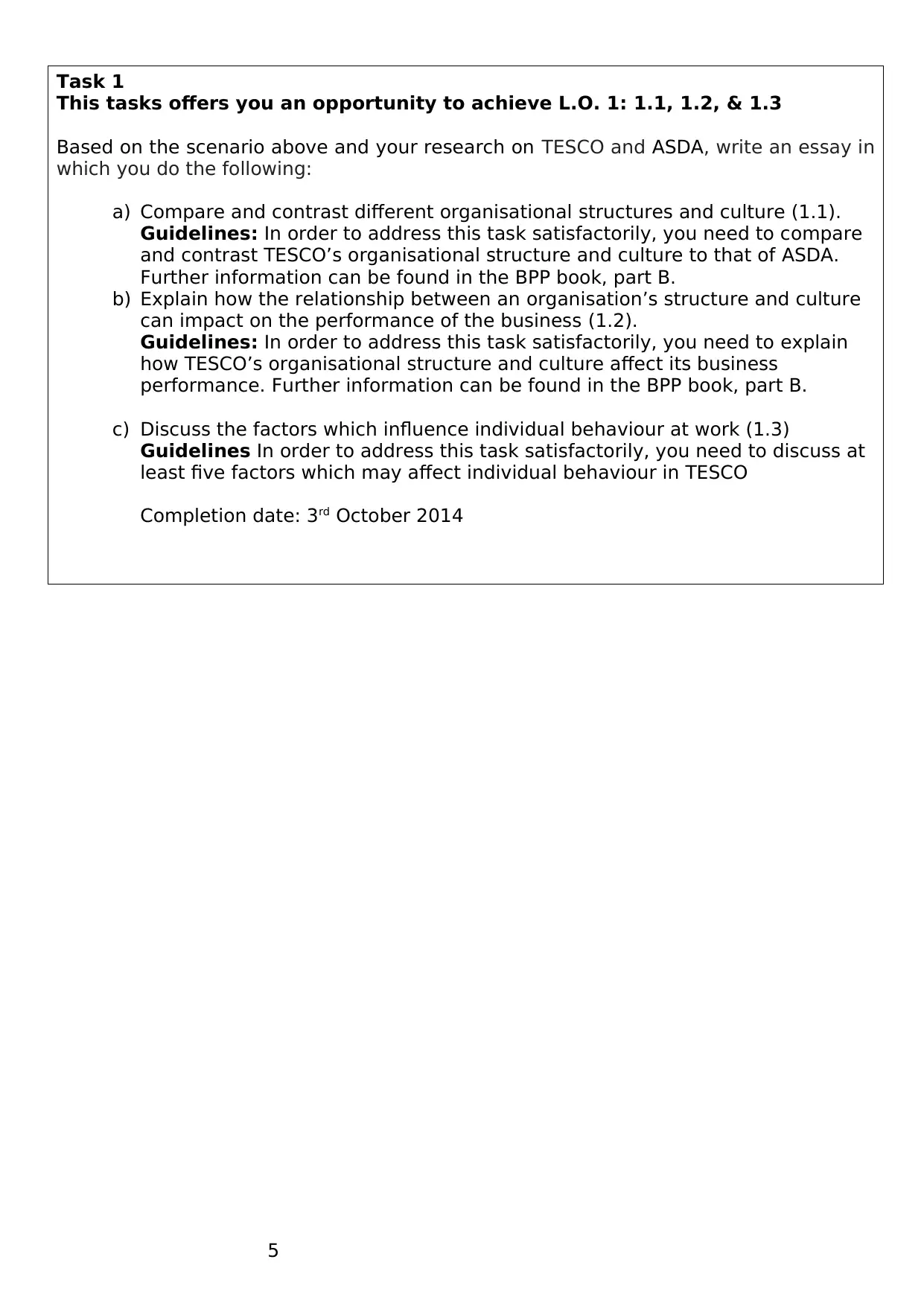
Task 1
This tasks offers you an opportunity to achieve L.O. 1: 1.1, 1.2, & 1.3
Based on the scenario above and your research on TESCO and ASDA, write an essay in
which you do the following:
a) Compare and contrast different organisational structures and culture (1.1).
Guidelines: In order to address this task satisfactorily, you need to compare
and contrast TESCO’s organisational structure and culture to that of ASDA.
Further information can be found in the BPP book, part B.
b) Explain how the relationship between an organisation’s structure and culture
can impact on the performance of the business (1.2).
Guidelines: In order to address this task satisfactorily, you need to explain
how TESCO’s organisational structure and culture affect its business
performance. Further information can be found in the BPP book, part B.
c) Discuss the factors which influence individual behaviour at work (1.3)
Guidelines In order to address this task satisfactorily, you need to discuss at
least five factors which may affect individual behaviour in TESCO
Completion date: 3rd October 2014
5
This tasks offers you an opportunity to achieve L.O. 1: 1.1, 1.2, & 1.3
Based on the scenario above and your research on TESCO and ASDA, write an essay in
which you do the following:
a) Compare and contrast different organisational structures and culture (1.1).
Guidelines: In order to address this task satisfactorily, you need to compare
and contrast TESCO’s organisational structure and culture to that of ASDA.
Further information can be found in the BPP book, part B.
b) Explain how the relationship between an organisation’s structure and culture
can impact on the performance of the business (1.2).
Guidelines: In order to address this task satisfactorily, you need to explain
how TESCO’s organisational structure and culture affect its business
performance. Further information can be found in the BPP book, part B.
c) Discuss the factors which influence individual behaviour at work (1.3)
Guidelines In order to address this task satisfactorily, you need to discuss at
least five factors which may affect individual behaviour in TESCO
Completion date: 3rd October 2014
5
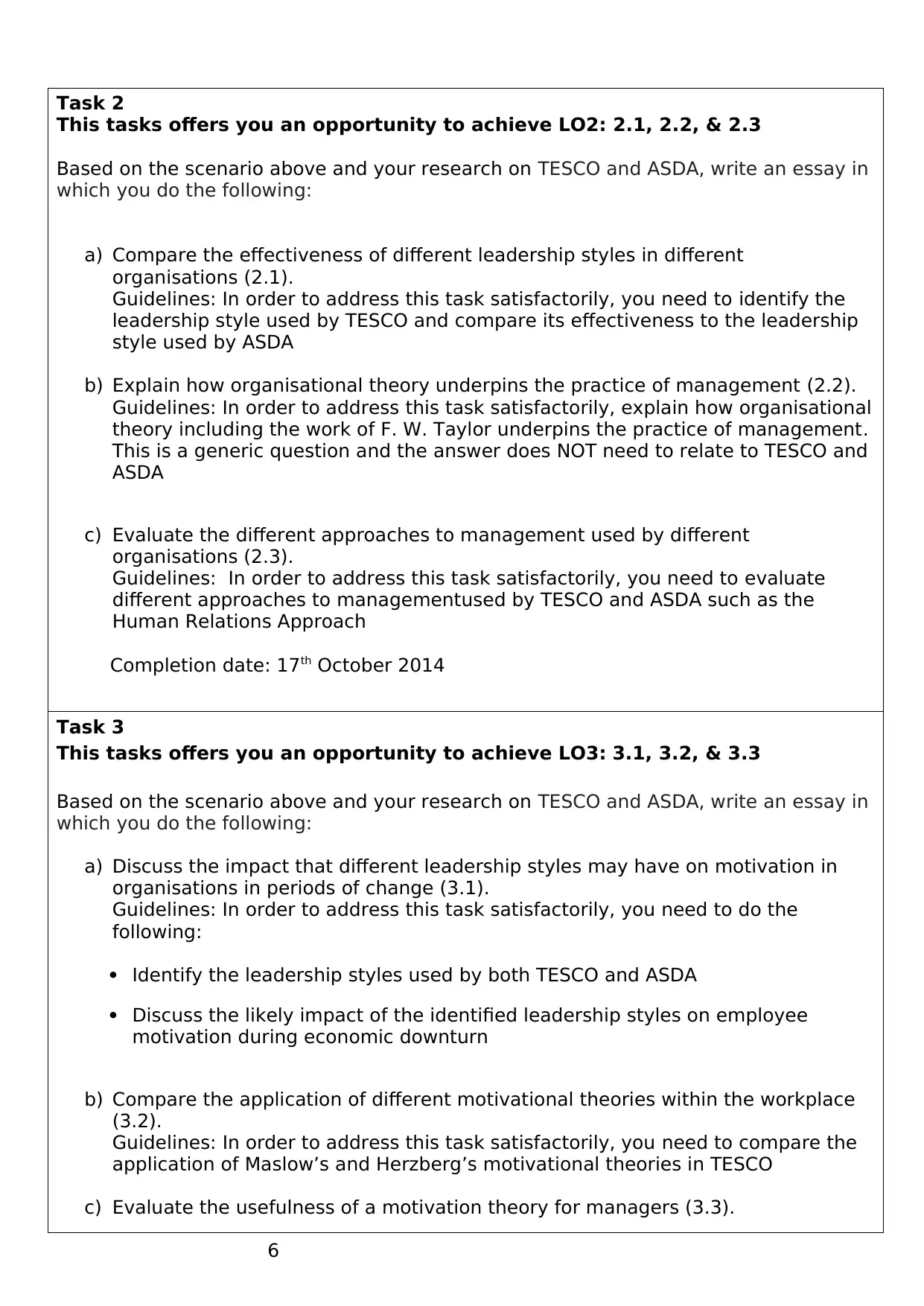
Task 2
This tasks offers you an opportunity to achieve LO2: 2.1, 2.2, & 2.3
Based on the scenario above and your research on TESCO and ASDA, write an essay in
which you do the following:
a) Compare the effectiveness of different leadership styles in different
organisations (2.1).
Guidelines: In order to address this task satisfactorily, you need to identify the
leadership style used by TESCO and compare its effectiveness to the leadership
style used by ASDA
b) Explain how organisational theory underpins the practice of management (2.2).
Guidelines: In order to address this task satisfactorily, explain how organisational
theory including the work of F. W. Taylor underpins the practice of management.
This is a generic question and the answer does NOT need to relate to TESCO and
ASDA
c) Evaluate the different approaches to management used by different
organisations (2.3).
Guidelines: In order to address this task satisfactorily, you need to evaluate
different approaches to managementused by TESCO and ASDA such as the
Human Relations Approach
Completion date: 17th October 2014
Task 3
This tasks offers you an opportunity to achieve LO3: 3.1, 3.2, & 3.3
Based on the scenario above and your research on TESCO and ASDA, write an essay in
which you do the following:
a) Discuss the impact that different leadership styles may have on motivation in
organisations in periods of change (3.1).
Guidelines: In order to address this task satisfactorily, you need to do the
following:
Identify the leadership styles used by both TESCO and ASDA
Discuss the likely impact of the identified leadership styles on employee
motivation during economic downturn
b) Compare the application of different motivational theories within the workplace
(3.2).
Guidelines: In order to address this task satisfactorily, you need to compare the
application of Maslow’s and Herzberg’s motivational theories in TESCO
c) Evaluate the usefulness of a motivation theory for managers (3.3).
6
This tasks offers you an opportunity to achieve LO2: 2.1, 2.2, & 2.3
Based on the scenario above and your research on TESCO and ASDA, write an essay in
which you do the following:
a) Compare the effectiveness of different leadership styles in different
organisations (2.1).
Guidelines: In order to address this task satisfactorily, you need to identify the
leadership style used by TESCO and compare its effectiveness to the leadership
style used by ASDA
b) Explain how organisational theory underpins the practice of management (2.2).
Guidelines: In order to address this task satisfactorily, explain how organisational
theory including the work of F. W. Taylor underpins the practice of management.
This is a generic question and the answer does NOT need to relate to TESCO and
ASDA
c) Evaluate the different approaches to management used by different
organisations (2.3).
Guidelines: In order to address this task satisfactorily, you need to evaluate
different approaches to managementused by TESCO and ASDA such as the
Human Relations Approach
Completion date: 17th October 2014
Task 3
This tasks offers you an opportunity to achieve LO3: 3.1, 3.2, & 3.3
Based on the scenario above and your research on TESCO and ASDA, write an essay in
which you do the following:
a) Discuss the impact that different leadership styles may have on motivation in
organisations in periods of change (3.1).
Guidelines: In order to address this task satisfactorily, you need to do the
following:
Identify the leadership styles used by both TESCO and ASDA
Discuss the likely impact of the identified leadership styles on employee
motivation during economic downturn
b) Compare the application of different motivational theories within the workplace
(3.2).
Guidelines: In order to address this task satisfactorily, you need to compare the
application of Maslow’s and Herzberg’s motivational theories in TESCO
c) Evaluate the usefulness of a motivation theory for managers (3.3).
6
⊘ This is a preview!⊘
Do you want full access?
Subscribe today to unlock all pages.

Trusted by 1+ million students worldwide
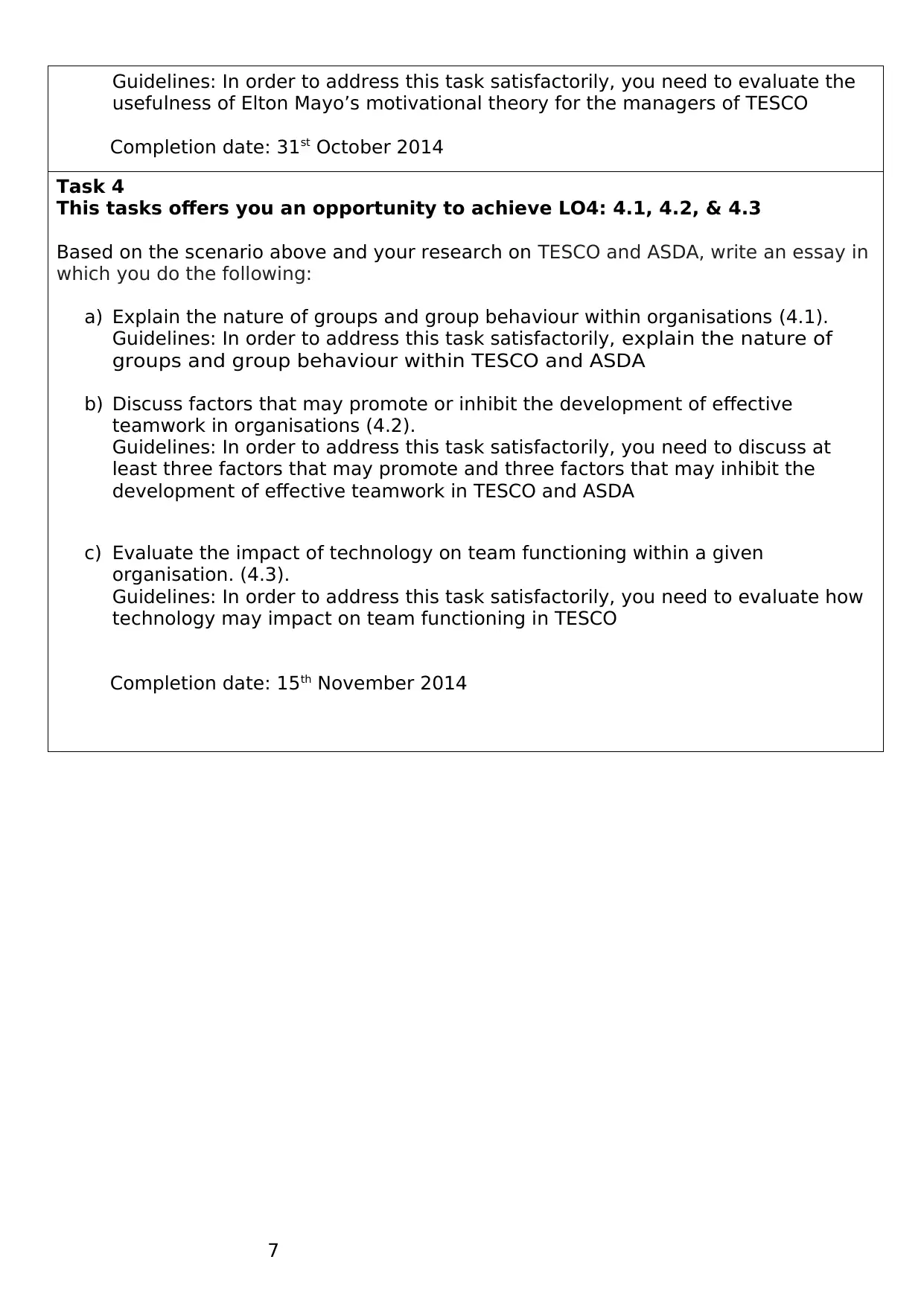
Guidelines: In order to address this task satisfactorily, you need to evaluate the
usefulness of Elton Mayo’s motivational theory for the managers of TESCO
Completion date: 31st October 2014
Task 4
This tasks offers you an opportunity to achieve LO4: 4.1, 4.2, & 4.3
Based on the scenario above and your research on TESCO and ASDA, write an essay in
which you do the following:
a) Explain the nature of groups and group behaviour within organisations (4.1).
Guidelines: In order to address this task satisfactorily, explain the nature of
groups and group behaviour within TESCO and ASDA
b) Discuss factors that may promote or inhibit the development of effective
teamwork in organisations (4.2).
Guidelines: In order to address this task satisfactorily, you need to discuss at
least three factors that may promote and three factors that may inhibit the
development of effective teamwork in TESCO and ASDA
c) Evaluate the impact of technology on team functioning within a given
organisation. (4.3).
Guidelines: In order to address this task satisfactorily, you need to evaluate how
technology may impact on team functioning in TESCO
Completion date: 15th November 2014
7
usefulness of Elton Mayo’s motivational theory for the managers of TESCO
Completion date: 31st October 2014
Task 4
This tasks offers you an opportunity to achieve LO4: 4.1, 4.2, & 4.3
Based on the scenario above and your research on TESCO and ASDA, write an essay in
which you do the following:
a) Explain the nature of groups and group behaviour within organisations (4.1).
Guidelines: In order to address this task satisfactorily, explain the nature of
groups and group behaviour within TESCO and ASDA
b) Discuss factors that may promote or inhibit the development of effective
teamwork in organisations (4.2).
Guidelines: In order to address this task satisfactorily, you need to discuss at
least three factors that may promote and three factors that may inhibit the
development of effective teamwork in TESCO and ASDA
c) Evaluate the impact of technology on team functioning within a given
organisation. (4.3).
Guidelines: In order to address this task satisfactorily, you need to evaluate how
technology may impact on team functioning in TESCO
Completion date: 15th November 2014
7
Paraphrase This Document
Need a fresh take? Get an instant paraphrase of this document with our AI Paraphraser

Answer Sheet
8
8
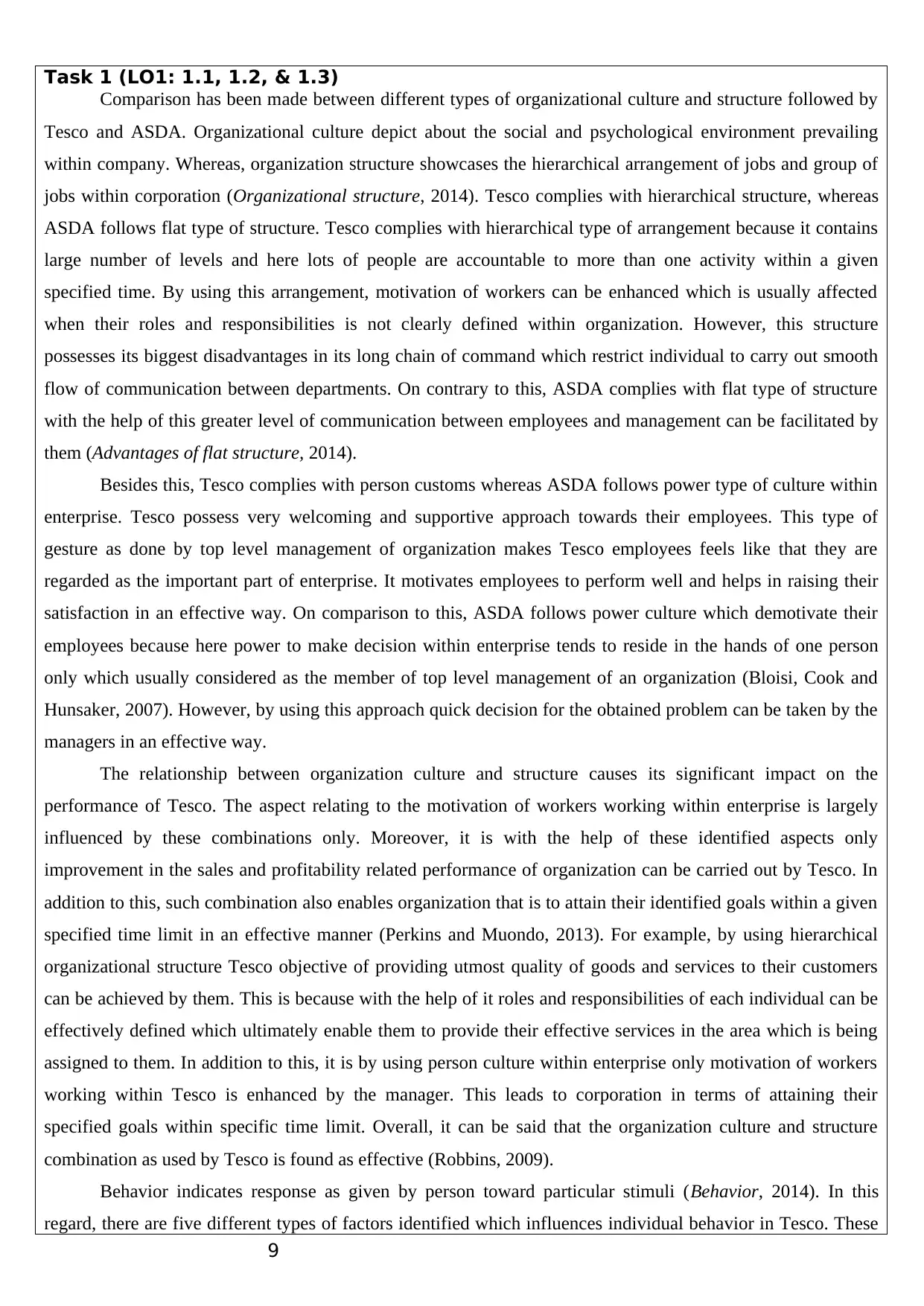
Task 1 (LO1: 1.1, 1.2, & 1.3)
Comparison has been made between different types of organizational culture and structure followed by
Tesco and ASDA. Organizational culture depict about the social and psychological environment prevailing
within company. Whereas, organization structure showcases the hierarchical arrangement of jobs and group of
jobs within corporation (Organizational structure, 2014). Tesco complies with hierarchical structure, whereas
ASDA follows flat type of structure. Tesco complies with hierarchical type of arrangement because it contains
large number of levels and here lots of people are accountable to more than one activity within a given
specified time. By using this arrangement, motivation of workers can be enhanced which is usually affected
when their roles and responsibilities is not clearly defined within organization. However, this structure
possesses its biggest disadvantages in its long chain of command which restrict individual to carry out smooth
flow of communication between departments. On contrary to this, ASDA complies with flat type of structure
with the help of this greater level of communication between employees and management can be facilitated by
them (Advantages of flat structure, 2014).
Besides this, Tesco complies with person customs whereas ASDA follows power type of culture within
enterprise. Tesco possess very welcoming and supportive approach towards their employees. This type of
gesture as done by top level management of organization makes Tesco employees feels like that they are
regarded as the important part of enterprise. It motivates employees to perform well and helps in raising their
satisfaction in an effective way. On comparison to this, ASDA follows power culture which demotivate their
employees because here power to make decision within enterprise tends to reside in the hands of one person
only which usually considered as the member of top level management of an organization (Bloisi, Cook and
Hunsaker, 2007). However, by using this approach quick decision for the obtained problem can be taken by the
managers in an effective way.
The relationship between organization culture and structure causes its significant impact on the
performance of Tesco. The aspect relating to the motivation of workers working within enterprise is largely
influenced by these combinations only. Moreover, it is with the help of these identified aspects only
improvement in the sales and profitability related performance of organization can be carried out by Tesco. In
addition to this, such combination also enables organization that is to attain their identified goals within a given
specified time limit in an effective manner (Perkins and Muondo, 2013). For example, by using hierarchical
organizational structure Tesco objective of providing utmost quality of goods and services to their customers
can be achieved by them. This is because with the help of it roles and responsibilities of each individual can be
effectively defined which ultimately enable them to provide their effective services in the area which is being
assigned to them. In addition to this, it is by using person culture within enterprise only motivation of workers
working within Tesco is enhanced by the manager. This leads to corporation in terms of attaining their
specified goals within specific time limit. Overall, it can be said that the organization culture and structure
combination as used by Tesco is found as effective (Robbins, 2009).
Behavior indicates response as given by person toward particular stimuli (Behavior, 2014). In this
regard, there are five different types of factors identified which influences individual behavior in Tesco. These
9
Comparison has been made between different types of organizational culture and structure followed by
Tesco and ASDA. Organizational culture depict about the social and psychological environment prevailing
within company. Whereas, organization structure showcases the hierarchical arrangement of jobs and group of
jobs within corporation (Organizational structure, 2014). Tesco complies with hierarchical structure, whereas
ASDA follows flat type of structure. Tesco complies with hierarchical type of arrangement because it contains
large number of levels and here lots of people are accountable to more than one activity within a given
specified time. By using this arrangement, motivation of workers can be enhanced which is usually affected
when their roles and responsibilities is not clearly defined within organization. However, this structure
possesses its biggest disadvantages in its long chain of command which restrict individual to carry out smooth
flow of communication between departments. On contrary to this, ASDA complies with flat type of structure
with the help of this greater level of communication between employees and management can be facilitated by
them (Advantages of flat structure, 2014).
Besides this, Tesco complies with person customs whereas ASDA follows power type of culture within
enterprise. Tesco possess very welcoming and supportive approach towards their employees. This type of
gesture as done by top level management of organization makes Tesco employees feels like that they are
regarded as the important part of enterprise. It motivates employees to perform well and helps in raising their
satisfaction in an effective way. On comparison to this, ASDA follows power culture which demotivate their
employees because here power to make decision within enterprise tends to reside in the hands of one person
only which usually considered as the member of top level management of an organization (Bloisi, Cook and
Hunsaker, 2007). However, by using this approach quick decision for the obtained problem can be taken by the
managers in an effective way.
The relationship between organization culture and structure causes its significant impact on the
performance of Tesco. The aspect relating to the motivation of workers working within enterprise is largely
influenced by these combinations only. Moreover, it is with the help of these identified aspects only
improvement in the sales and profitability related performance of organization can be carried out by Tesco. In
addition to this, such combination also enables organization that is to attain their identified goals within a given
specified time limit in an effective manner (Perkins and Muondo, 2013). For example, by using hierarchical
organizational structure Tesco objective of providing utmost quality of goods and services to their customers
can be achieved by them. This is because with the help of it roles and responsibilities of each individual can be
effectively defined which ultimately enable them to provide their effective services in the area which is being
assigned to them. In addition to this, it is by using person culture within enterprise only motivation of workers
working within Tesco is enhanced by the manager. This leads to corporation in terms of attaining their
specified goals within specific time limit. Overall, it can be said that the organization culture and structure
combination as used by Tesco is found as effective (Robbins, 2009).
Behavior indicates response as given by person toward particular stimuli (Behavior, 2014). In this
regard, there are five different types of factors identified which influences individual behavior in Tesco. These
9
⊘ This is a preview!⊘
Do you want full access?
Subscribe today to unlock all pages.

Trusted by 1+ million students worldwide
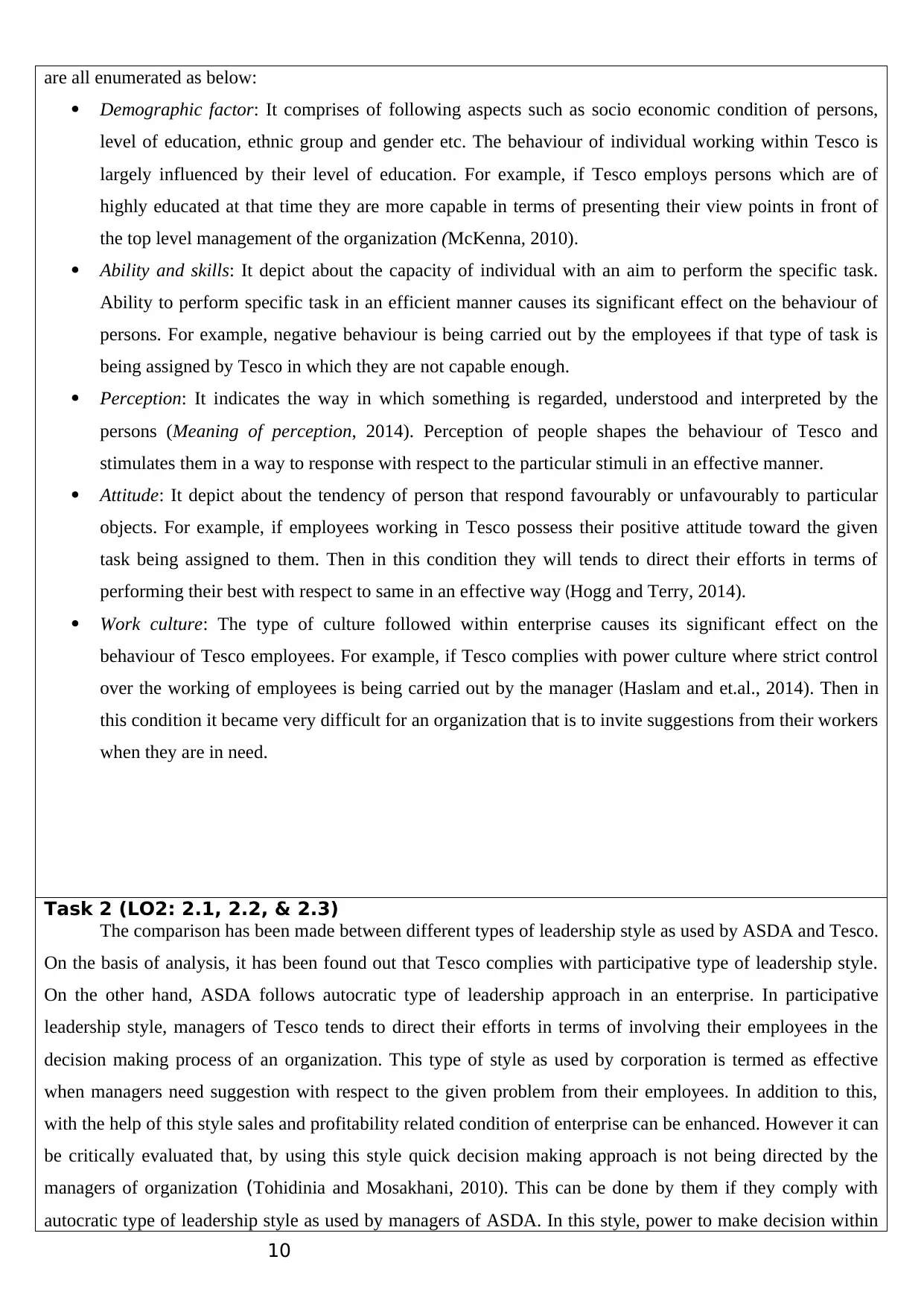
are all enumerated as below:
Demographic factor: It comprises of following aspects such as socio economic condition of persons,
level of education, ethnic group and gender etc. The behaviour of individual working within Tesco is
largely influenced by their level of education. For example, if Tesco employs persons which are of
highly educated at that time they are more capable in terms of presenting their view points in front of
the top level management of the organization (McKenna, 2010).
Ability and skills: It depict about the capacity of individual with an aim to perform the specific task.
Ability to perform specific task in an efficient manner causes its significant effect on the behaviour of
persons. For example, negative behaviour is being carried out by the employees if that type of task is
being assigned by Tesco in which they are not capable enough.
Perception: It indicates the way in which something is regarded, understood and interpreted by the
persons (Meaning of perception, 2014). Perception of people shapes the behaviour of Tesco and
stimulates them in a way to response with respect to the particular stimuli in an effective manner.
Attitude: It depict about the tendency of person that respond favourably or unfavourably to particular
objects. For example, if employees working in Tesco possess their positive attitude toward the given
task being assigned to them. Then in this condition they will tends to direct their efforts in terms of
performing their best with respect to same in an effective way (Hogg and Terry, 2014).
Work culture: The type of culture followed within enterprise causes its significant effect on the
behaviour of Tesco employees. For example, if Tesco complies with power culture where strict control
over the working of employees is being carried out by the manager (Haslam and et.al., 2014). Then in
this condition it became very difficult for an organization that is to invite suggestions from their workers
when they are in need.
Task 2 (LO2: 2.1, 2.2, & 2.3)
The comparison has been made between different types of leadership style as used by ASDA and Tesco.
On the basis of analysis, it has been found out that Tesco complies with participative type of leadership style.
On the other hand, ASDA follows autocratic type of leadership approach in an enterprise. In participative
leadership style, managers of Tesco tends to direct their efforts in terms of involving their employees in the
decision making process of an organization. This type of style as used by corporation is termed as effective
when managers need suggestion with respect to the given problem from their employees. In addition to this,
with the help of this style sales and profitability related condition of enterprise can be enhanced. However it can
be critically evaluated that, by using this style quick decision making approach is not being directed by the
managers of organization (Tohidinia and Mosakhani, 2010). This can be done by them if they comply with
autocratic type of leadership style as used by managers of ASDA. In this style, power to make decision within
10
Demographic factor: It comprises of following aspects such as socio economic condition of persons,
level of education, ethnic group and gender etc. The behaviour of individual working within Tesco is
largely influenced by their level of education. For example, if Tesco employs persons which are of
highly educated at that time they are more capable in terms of presenting their view points in front of
the top level management of the organization (McKenna, 2010).
Ability and skills: It depict about the capacity of individual with an aim to perform the specific task.
Ability to perform specific task in an efficient manner causes its significant effect on the behaviour of
persons. For example, negative behaviour is being carried out by the employees if that type of task is
being assigned by Tesco in which they are not capable enough.
Perception: It indicates the way in which something is regarded, understood and interpreted by the
persons (Meaning of perception, 2014). Perception of people shapes the behaviour of Tesco and
stimulates them in a way to response with respect to the particular stimuli in an effective manner.
Attitude: It depict about the tendency of person that respond favourably or unfavourably to particular
objects. For example, if employees working in Tesco possess their positive attitude toward the given
task being assigned to them. Then in this condition they will tends to direct their efforts in terms of
performing their best with respect to same in an effective way (Hogg and Terry, 2014).
Work culture: The type of culture followed within enterprise causes its significant effect on the
behaviour of Tesco employees. For example, if Tesco complies with power culture where strict control
over the working of employees is being carried out by the manager (Haslam and et.al., 2014). Then in
this condition it became very difficult for an organization that is to invite suggestions from their workers
when they are in need.
Task 2 (LO2: 2.1, 2.2, & 2.3)
The comparison has been made between different types of leadership style as used by ASDA and Tesco.
On the basis of analysis, it has been found out that Tesco complies with participative type of leadership style.
On the other hand, ASDA follows autocratic type of leadership approach in an enterprise. In participative
leadership style, managers of Tesco tends to direct their efforts in terms of involving their employees in the
decision making process of an organization. This type of style as used by corporation is termed as effective
when managers need suggestion with respect to the given problem from their employees. In addition to this,
with the help of this style sales and profitability related condition of enterprise can be enhanced. However it can
be critically evaluated that, by using this style quick decision making approach is not being directed by the
managers of organization (Tohidinia and Mosakhani, 2010). This can be done by them if they comply with
autocratic type of leadership style as used by managers of ASDA. In this style, power to make decision within
10
Paraphrase This Document
Need a fresh take? Get an instant paraphrase of this document with our AI Paraphraser
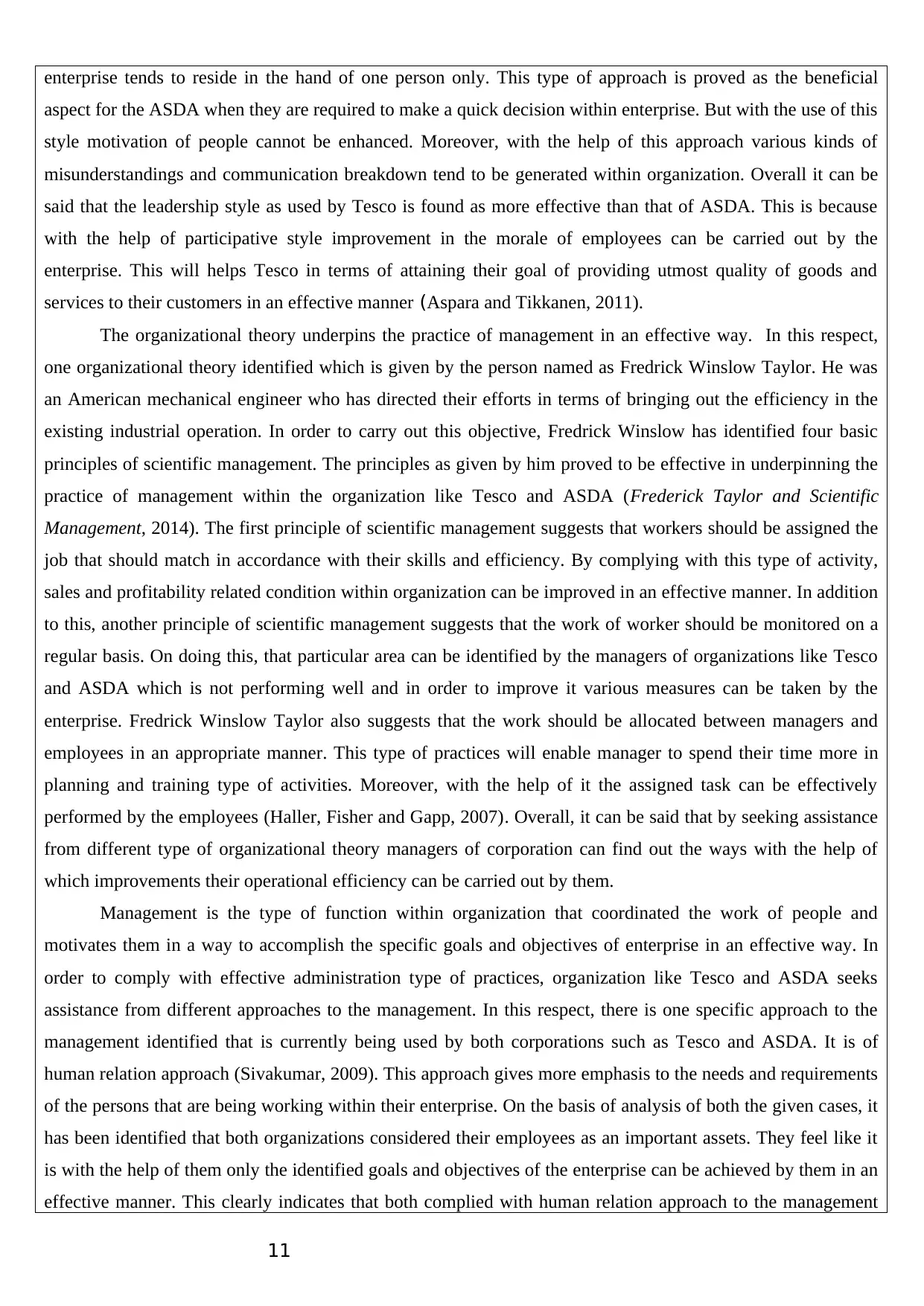
enterprise tends to reside in the hand of one person only. This type of approach is proved as the beneficial
aspect for the ASDA when they are required to make a quick decision within enterprise. But with the use of this
style motivation of people cannot be enhanced. Moreover, with the help of this approach various kinds of
misunderstandings and communication breakdown tend to be generated within organization. Overall it can be
said that the leadership style as used by Tesco is found as more effective than that of ASDA. This is because
with the help of participative style improvement in the morale of employees can be carried out by the
enterprise. This will helps Tesco in terms of attaining their goal of providing utmost quality of goods and
services to their customers in an effective manner (Aspara and Tikkanen, 2011).
The organizational theory underpins the practice of management in an effective way. In this respect,
one organizational theory identified which is given by the person named as Fredrick Winslow Taylor. He was
an American mechanical engineer who has directed their efforts in terms of bringing out the efficiency in the
existing industrial operation. In order to carry out this objective, Fredrick Winslow has identified four basic
principles of scientific management. The principles as given by him proved to be effective in underpinning the
practice of management within the organization like Tesco and ASDA (Frederick Taylor and Scientific
Management, 2014). The first principle of scientific management suggests that workers should be assigned the
job that should match in accordance with their skills and efficiency. By complying with this type of activity,
sales and profitability related condition within organization can be improved in an effective manner. In addition
to this, another principle of scientific management suggests that the work of worker should be monitored on a
regular basis. On doing this, that particular area can be identified by the managers of organizations like Tesco
and ASDA which is not performing well and in order to improve it various measures can be taken by the
enterprise. Fredrick Winslow Taylor also suggests that the work should be allocated between managers and
employees in an appropriate manner. This type of practices will enable manager to spend their time more in
planning and training type of activities. Moreover, with the help of it the assigned task can be effectively
performed by the employees (Haller, Fisher and Gapp, 2007). Overall, it can be said that by seeking assistance
from different type of organizational theory managers of corporation can find out the ways with the help of
which improvements their operational efficiency can be carried out by them.
Management is the type of function within organization that coordinated the work of people and
motivates them in a way to accomplish the specific goals and objectives of enterprise in an effective way. In
order to comply with effective administration type of practices, organization like Tesco and ASDA seeks
assistance from different approaches to the management. In this respect, there is one specific approach to the
management identified that is currently being used by both corporations such as Tesco and ASDA. It is of
human relation approach (Sivakumar, 2009). This approach gives more emphasis to the needs and requirements
of the persons that are being working within their enterprise. On the basis of analysis of both the given cases, it
has been identified that both organizations considered their employees as an important assets. They feel like it
is with the help of them only the identified goals and objectives of the enterprise can be achieved by them in an
effective manner. This clearly indicates that both complied with human relation approach to the management
11
aspect for the ASDA when they are required to make a quick decision within enterprise. But with the use of this
style motivation of people cannot be enhanced. Moreover, with the help of this approach various kinds of
misunderstandings and communication breakdown tend to be generated within organization. Overall it can be
said that the leadership style as used by Tesco is found as more effective than that of ASDA. This is because
with the help of participative style improvement in the morale of employees can be carried out by the
enterprise. This will helps Tesco in terms of attaining their goal of providing utmost quality of goods and
services to their customers in an effective manner (Aspara and Tikkanen, 2011).
The organizational theory underpins the practice of management in an effective way. In this respect,
one organizational theory identified which is given by the person named as Fredrick Winslow Taylor. He was
an American mechanical engineer who has directed their efforts in terms of bringing out the efficiency in the
existing industrial operation. In order to carry out this objective, Fredrick Winslow has identified four basic
principles of scientific management. The principles as given by him proved to be effective in underpinning the
practice of management within the organization like Tesco and ASDA (Frederick Taylor and Scientific
Management, 2014). The first principle of scientific management suggests that workers should be assigned the
job that should match in accordance with their skills and efficiency. By complying with this type of activity,
sales and profitability related condition within organization can be improved in an effective manner. In addition
to this, another principle of scientific management suggests that the work of worker should be monitored on a
regular basis. On doing this, that particular area can be identified by the managers of organizations like Tesco
and ASDA which is not performing well and in order to improve it various measures can be taken by the
enterprise. Fredrick Winslow Taylor also suggests that the work should be allocated between managers and
employees in an appropriate manner. This type of practices will enable manager to spend their time more in
planning and training type of activities. Moreover, with the help of it the assigned task can be effectively
performed by the employees (Haller, Fisher and Gapp, 2007). Overall, it can be said that by seeking assistance
from different type of organizational theory managers of corporation can find out the ways with the help of
which improvements their operational efficiency can be carried out by them.
Management is the type of function within organization that coordinated the work of people and
motivates them in a way to accomplish the specific goals and objectives of enterprise in an effective way. In
order to comply with effective administration type of practices, organization like Tesco and ASDA seeks
assistance from different approaches to the management. In this respect, there is one specific approach to the
management identified that is currently being used by both corporations such as Tesco and ASDA. It is of
human relation approach (Sivakumar, 2009). This approach gives more emphasis to the needs and requirements
of the persons that are being working within their enterprise. On the basis of analysis of both the given cases, it
has been identified that both organizations considered their employees as an important assets. They feel like it
is with the help of them only the identified goals and objectives of the enterprise can be achieved by them in an
effective manner. This clearly indicates that both complied with human relation approach to the management
11
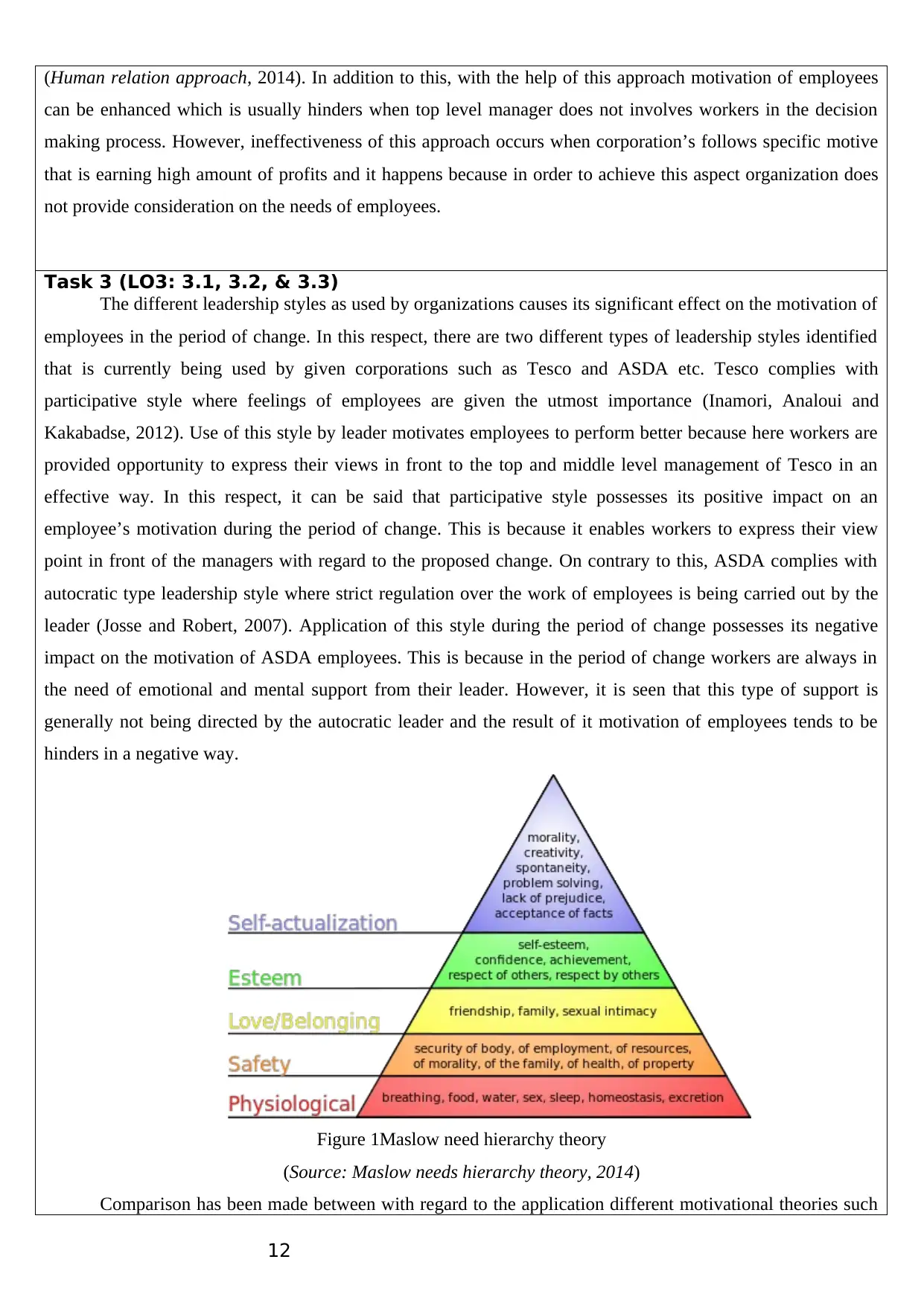
(Human relation approach, 2014). In addition to this, with the help of this approach motivation of employees
can be enhanced which is usually hinders when top level manager does not involves workers in the decision
making process. However, ineffectiveness of this approach occurs when corporation’s follows specific motive
that is earning high amount of profits and it happens because in order to achieve this aspect organization does
not provide consideration on the needs of employees.
Task 3 (LO3: 3.1, 3.2, & 3.3)
The different leadership styles as used by organizations causes its significant effect on the motivation of
employees in the period of change. In this respect, there are two different types of leadership styles identified
that is currently being used by given corporations such as Tesco and ASDA etc. Tesco complies with
participative style where feelings of employees are given the utmost importance (Inamori, Analoui and
Kakabadse, 2012). Use of this style by leader motivates employees to perform better because here workers are
provided opportunity to express their views in front to the top and middle level management of Tesco in an
effective way. In this respect, it can be said that participative style possesses its positive impact on an
employee’s motivation during the period of change. This is because it enables workers to express their view
point in front of the managers with regard to the proposed change. On contrary to this, ASDA complies with
autocratic type leadership style where strict regulation over the work of employees is being carried out by the
leader (Josse and Robert, 2007). Application of this style during the period of change possesses its negative
impact on the motivation of ASDA employees. This is because in the period of change workers are always in
the need of emotional and mental support from their leader. However, it is seen that this type of support is
generally not being directed by the autocratic leader and the result of it motivation of employees tends to be
hinders in a negative way.
Figure 1Maslow need hierarchy theory
(Source: Maslow needs hierarchy theory, 2014)
Comparison has been made between with regard to the application different motivational theories such
12
can be enhanced which is usually hinders when top level manager does not involves workers in the decision
making process. However, ineffectiveness of this approach occurs when corporation’s follows specific motive
that is earning high amount of profits and it happens because in order to achieve this aspect organization does
not provide consideration on the needs of employees.
Task 3 (LO3: 3.1, 3.2, & 3.3)
The different leadership styles as used by organizations causes its significant effect on the motivation of
employees in the period of change. In this respect, there are two different types of leadership styles identified
that is currently being used by given corporations such as Tesco and ASDA etc. Tesco complies with
participative style where feelings of employees are given the utmost importance (Inamori, Analoui and
Kakabadse, 2012). Use of this style by leader motivates employees to perform better because here workers are
provided opportunity to express their views in front to the top and middle level management of Tesco in an
effective way. In this respect, it can be said that participative style possesses its positive impact on an
employee’s motivation during the period of change. This is because it enables workers to express their view
point in front of the managers with regard to the proposed change. On contrary to this, ASDA complies with
autocratic type leadership style where strict regulation over the work of employees is being carried out by the
leader (Josse and Robert, 2007). Application of this style during the period of change possesses its negative
impact on the motivation of ASDA employees. This is because in the period of change workers are always in
the need of emotional and mental support from their leader. However, it is seen that this type of support is
generally not being directed by the autocratic leader and the result of it motivation of employees tends to be
hinders in a negative way.
Figure 1Maslow need hierarchy theory
(Source: Maslow needs hierarchy theory, 2014)
Comparison has been made between with regard to the application different motivational theories such
12
⊘ This is a preview!⊘
Do you want full access?
Subscribe today to unlock all pages.

Trusted by 1+ million students worldwide
1 out of 16
Related Documents
Your All-in-One AI-Powered Toolkit for Academic Success.
+13062052269
info@desklib.com
Available 24*7 on WhatsApp / Email
![[object Object]](/_next/static/media/star-bottom.7253800d.svg)
Unlock your academic potential
Copyright © 2020–2025 A2Z Services. All Rights Reserved. Developed and managed by ZUCOL.





